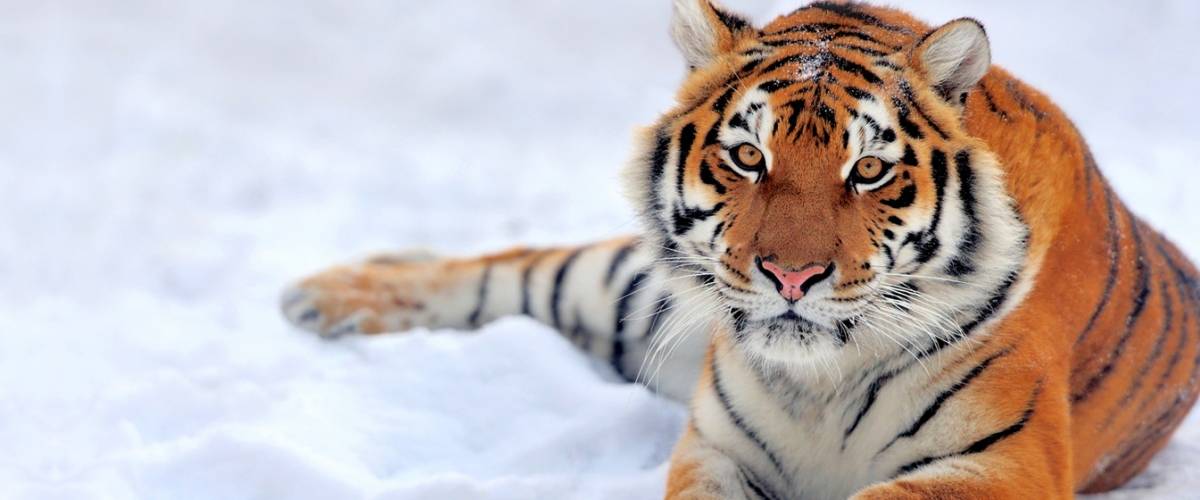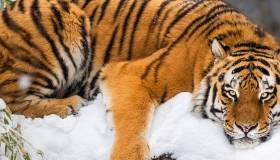
July 29, 2021 – About a century ago, an estimated 100,000 tigers roamed freely throughout Asia. Today, tiger numbers have sharply declined with fewer than 4,000 tigers remaining in the wild. Threats to tigers are many, including shrinking habitats, human-tiger conflicts and poaching. At Morris Animal Foundation, we focus on another important threat – emerging diseases in already fragmented tiger populations that could contribute to local extinctions.
CANINE DISTEMPER
Canine distemper is a contagious and potentially serious disease caused by a virus that attacks the respiratory, gastrointestinal and nervous systems of puppies and dogs. Unfortunately, this disease has spilled over into many different wildlife species and now is a growing concern for tigers.
About a decade ago, Morris Animal Foundation-funded researchers at the Wildlife Conservation Society noted a dramatic decline in a well-studied tiger population in Russia’s Far East. They discovered that some of the tigers were dying of canine distemper virus (CDV) infection. With fewer than 400 Siberian tigers left in the wild, the team had to act fast. They mobilized a group of experts, including epidemiologists and virologists experienced in CDV research, to deal with the crisis.
The team set out to identify the source of the spillover infection and find ways to control disease spread to the critically endangered tigers. They knew CDV does not survive for long periods in the environment, and that the tiger populations were too small to maintain and perpetuate infections amongst themselves. So, the team turned their attention to another source of infection – local wildlife and domestic animals that could act as reservoirs of disease. They collected health data on known CDV carriers, including domestic dogs, and wild carnivores such as foxes, raccoon dogs and badgers.
While statistical evidence provided little support to suggest that CDV was spilling over from the local rural dog populations, the data did reveal CDV infection is widespread and particularly abundant in several wild carnivore species. Data also showed CDV was most likely to impact tigers when population sizes declined below 50 individuals. Given the size and fractured nature of tiger populations across Asia, this is reason for concern.
The team analyzed blood samples from several wildlife species to compare genetic blueprints of virus strains across the region. This data confirmed that sable (a species of marten), raccoon dogs and Eurasian badgers likely are key species perpetuating the disease in the tiger ecosystem.
The bottom line was that simply vaccinating the domestic dog population would not remove the threat to the tigers, and that trying to vaccinate the local wildlife would be difficult and impractical. The team had to come up with another solution, and fast.
After further analysis, the team concluded the best management approach appeared to be direct vaccination of the big cats themselves.
Computer simulations suggest that vaccinating even a small percentage of an isolated tiger population could significantly increase the probability of survival. Research is underway to assess the safety and efficacy of existing vaccines for use in tigers and other big cats at risk from CDV infections. Thanks to the collaboration of many scientists and conservationists, tigers in zoos now are widely vaccinated against CDV infection. Unfortunately, no wild tigers have been vaccinated. But scientists, armed with new data, are working to convince the governments in countries where the tigers live to consider this strategy.
AN UNKNOWN NEW THREAT
Another potential viral threat to tigers is from the coronavirus that causes COVID-19, SARS-CoV-2. At this time, little information is available on whether this is a valid conservation concern for the species. There is good evidence that people can pass the virus to domestic cats and dogs. This seems to also be true for big cats and there are documented cases of SARS-CoV-2 passing from caretakers to big cats.
According to the Centers for Disease Control and Prevention, the first case in the United States of a captive wild animal testing positive for SARS-Co-V-2 was a tiger at New York City’s Bronx Zoo. Since then, numerous other zoo animals have tested positive for the disease, including lions, cougars, snow leopards and gorillas. In many cases, these infections happened despite control efforts, including staff wearing protective equipment and following COVID-19 protocols.
Fortunately, many of these animals experienced mild respiratory symptoms and fully recovered. As a precautionary measure, zoos are starting to vaccinate at-risk animals, including tigers, using a vaccine specially designed to protect wildlife.
How COVID-19 spillover will bode for wild tigers is still unknown. Some countries, including India, home to most of the world’s wild tigers, have temporarily closed their tiger preserves to tourists. Conservationists are keeping a close eye on the situation, monitoring preserve wild cats for any signs of respiratory illness, including nasal discharge, coughing or breathing issues.
DEDICATED TO SAVING TIGERS
Morris Animal Foundation has funded tiger health studies for more than two decades. Early studies focused on improving reproduction and genetic management of captive tigers to help save the species from extinction. Today, our focus is on disease threats and improving the veterinary care for managed conservation animals.
The good news for tigers is despite mounting pressures, some tiger populations are seeing slight population increases. In Russia’s Far East, the 400 well-studied Siberian tigers from the CDV study are now up to more than 500 animals according to the World Wildlife Fund. This may not seem like much, but for an endangered species any increase is a big deal. While threats continue to be a major concern for many populations of tigers, ensuring tigers have habitat, protection and disease monitoring can make a difference.
Would you like to support research that helps tigers have longer, healthier lives? Learn how you can make a difference for tigers and animals everywhere.




